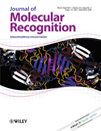Spatial and temporal dependence of the cerebral endothelial cells elasticity†
This article is published in Journal of Molecular Recognition as a focus on AFM on Life Sciences and Medicine, edited by Jean-Luc Pellequer and Pierre Parot (CEA Marcoule, Life Science Division, Bagnols sur Cèze, France).
Abstract
The reliable determination of the mechanical properties of a living cell is one of the most important challenges of the atomic force microscopic measurements. In the present study the spatial and temporal dependency of the force measurements on cerebral endothelial cells was investigated. Besides imaging the cells, two different sequences of force measurements were applied:
-
Acquisition of force curves in short time at several points across the cell surface investigating spatial dependence of the elasticity.
-
Acquisition of force curves for long time at a previously determined place, over the cell nucleus, which provides the temporal stability/variation of the measured forces/values.
Three different stages of endothelial cell cultures of the hCMEC/D3 cells were used: sub-confluent living, confluent living, and confluent fixed cells. The Young's modulus was calculated from the force curves using the Hertz model and the results were plotted against time or location correspondingly. The rational of using the three stage of culture was to clarify whether the observed effect belongs to the individual cell, to the ensemble of cells or just to some, not living cell component.
In case of sub-confluent cells the results revealed a softer nuclear region compared to the periphery, while an attenuated oscillation like fluctuation in time, with a period of about 10–30 min, was observed.
Confluent living cells showed similar tendencies to the sub-confluent cells, but the changes were larger and the temporal oscillations had longer period. The spatial dependency of the elasticity on confluent cells was confirmed by force–volume measurement too.
In case of fixed cells neither spatial nor temporal differences were observed between the nuclear and peripheral region, however the Young's modulus and the error of the measurement was larger, compared to the sub-confluent living cells. Copyright © 2011 John Wiley & Sons, Ltd.




